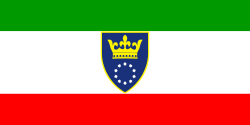| Flag | Date | Use | Description |
|---|
| Banate of Bosnia |
|---|
 | c. 1354 | Flag of the Bosnian Banate. | Swallow-tailed, a blue field with a white cross pattée in the center. |
| Kingdom of Bosnia |
|---|
|
 | 1377 - 1463 | Royal Flag of Tvrtko I of Bosnia. | A white field with 5 sestiere on the fly and the arms of Bosnia in the center. |
| Duchy of Saint Sava |
|---|
 | 1448 - 1482 | Flag of Herzegovina | A red field with 2 white crosses pattée off-centred toward the hoist and 3 sestiere on the fly. |
| Rama |
|---|
 | 1618 | Banner used for "Rama" at Ferdinand II's coronation as King of Hungary. | Swallow-tailed, a blue field with a shield in the center. |
| Ottoman Bosnia |
|---|
 | 1831 - 1832 | Flag used during the Bosnian uprising against the Ottomans. | During the struggle for Bosnia's autonomy from September 1831 to June 1832, a new Bosnian flag was adopted under the leadership of Husein-Captain Gradašćević. At the beginning of 1832, Bosnia and Herzegovina was freed from Ottoman rule for a short time and independence was declared. The flag used from 1831 to 1832 was green with a yellow moon and a five-pointed star in the middle. The flag began to be used with the beginning of the struggle against the Ottoman authorities on September 14, 1830. |
| Austro-Hungarian Bosnia |
|---|
 | 1878 - 1908 | Flag of the Austro-Hungarian-occupied Province of Bosnia | A red and yellow horizontal bicolour with a shield. The Province of Herzegovina used a similar flag but with the colors reversed (a yellow and red bicolour). |
 | 1908 - 1918 | Flag of the Condominium of Bosnia and Herzegovina | |
| Bosnia in Yugoslavia |
|---|
 | 1944 | Flag of Bosnian-Herzegovinian Partisans | |
 | 1946 - 1992 | Flag of the Socialist Republic of Bosnia and Herzegovina within Yugoslavia | A red field (symbolizing the national liberation movements) with the Yugoslav flag in the canton. |
| Independent Bosnia and Herzegovina |
|---|
 | 1993 - 1995 | Flag of Autonomous Province of Western Bosnia and Republic of Western Bosnia | |
 | 1992 - 1998 | Flag of the Republic of Bosnia and Herzegovina | A white field with a blue shield bearing six Bosnian Golden Lilies in the centre. It also was and it still is the main Bosniak national flag. |























































